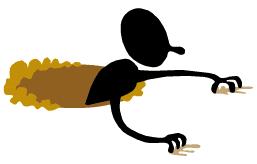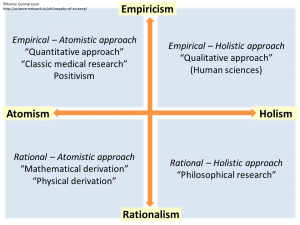Ronny Gunnarsson. Introduction to research [in Science Network TV]. Available at: https://science-network.tv/introduction-to-research/. Accessed July 6, 2025.
| Suggested pre-reading | What this web page adds |
|---|---|
| None | This web-page gives you with a brief overview of what research is and what differ research projects from other projects. This page will also briefly explain prerequisites for doing research and guide you how to commence doing research. You will have a better understanding of what research is after reading this page. |
New to research? Confused about it? No worries! I have been there and remember the feeling. Let me make a gentle start and gradually get there. This web-page aim to give a birds perspective on research. Most web-pages on this site cross-link to other pages with more information. However, it is important to understand the big picture before getting lost in details. Hence, I suggest you first read through this web-page once without clicking on any links. After doing that read it once more clicking on relevant links guiding you further (some other web-pages on this site is still under construction). If you get lost go back to this web-page again and start over. You can always find this web-page by clicking the “Panic button” on the start page.
Table of Contents (with links)
What is research?
Mankind has periodically tried to expand its knowledge. This has initially been done in a less systematic way. We gradually, and specifically after the scientific revolution during the 16th century, learned how to be more and more systematic in our search for new knowledge. This is science and its method is research. What differs research from any kind of learning we humans do? Research is almost always done as a project. This means that it has a start and an end. However, not all projects are research projects. Not even all projects aiming for new knowledge are research projects. The table below clarifies similarities and differences between four different types of projects all aiming to acquire new knowledge. The demarcation between the four types of projects aiming for new knowledge is not entirely crystal clear.
| Research | Development / implementation | Evaluation / Investigation | Quality assurance (Audit) | |
|---|---|---|---|---|
| Primary purpose | Create new theories or to confirm (or reject) existing theories | To implement a change in the organisation | To compile and sort (possibly recalculate) existing knowledge | To monitor or improve the quality of service delivered by an individual or an organisation |
| Use previous research in planning and interpretation of observations | +++ | ++ | ++ | + |
| Aim to create new knowledge | +++ | + | ++ | (+) |
| Physical, psychological, social and spiritual risk or inconvenience for participants | Can be low or high | Low | Always very low or none at all | Always very low |
| May need review by a research ethics committee | +++ | + | (+) | (+) |
| Collection of data | Any type needed to answer research questions | Routinely collected in the organisations day to day activities. | ||
| Strive to present structural quality: -What staff have been involved? -What were their special competence? -What kind of premises have been used? -What equipment was used? | ++ | +++ | (+) | + |
| Strive to present process quality: -How many meetings have been held? -How many came to the meetings? -How many samples have been taken? -How many surveys have been sent out? | ++ | +++ | (+) | + |
| Aim to present descriptive statistics | ++ | + | +++ | |
| Aim to present inferential statistics or a qualitative analysis drawing conclusions from observations | +++ | (+) | ||
| Aim to disseminate results outside own setting (preferably in a peer reviewed conference or scientific journal) | +++ | + | + | (+) |
| Aim to change current praxis | Varies | +++ | + | (+) |
| Linked to philosophical theories of how new knowledge can be created | +++ |
A standard development project / implementation project has its focus on implementing knowledge and we don’t label that as research. However, “implementation research” does not focus on the implementation but rather on identifying enablers and barriers to implementation, consequences of implementation if the setting is altered compared to the setting where the original studies were done and sustainability of implementation . Hence, “implementation” is not research but “implementation research” is.
Research projects are not “better” than audits, developmental / implementation projects or evaluations / investigations. These different types of projects are just… …different. The rest of this web-page (and this site as a whole) will focus solely on research projects. Research is more or less linked to philosophical theories informing about the best strategies to achieve new knowledge. Many procedures in statistics and qualitative research methods has their roots in these theories. You can do research without being familiar with these theories but having a brief knowledge of them may help in understanding why some things are done in a specific manner. However, bare in mind that the philosophical theories, and subsequent statistics and qualitative methods, are not static. They change over time, often slowly and subtle. The change is quicker in times of “scientific revolution” where some paradigms (the “spectacles” we use to view the world) undergo major changes.
Requirements for doing research
- Your own curiosity, creativity and ability for lateral thinking. Nurture your curiosity and creativity. One of the best ways to do this is to ensure that your journey of curiosity and creativity in research becomes as fun as possible. One of the most important practical things to implement is to celebrate any kind of success such as approval from a funding body or an ethics committee, start or finish of data collection or an acceptance of a manuscript. Failure to celebrate these events will have severe detrimental effects in the long run. Anyone being head of a research unit or graduate research school should emphasize the importance of this (and make appropriate practical arrangements).
- Having a lower than average intelligence may hinder creativity . However, average intelligence is usually enough . Very high intelligence may be beneficial but other personal factor such as openness is usually more important for creativity .
- Your own endurance and ability to get things done is very important. You need to understand that even fun journeys may occasionally have passages of dry desert walk. It is important that you don’t give up during desert walks and ensure you have a clear perspective of when the desert walk will end. Remember that most research projects takes longer time than anticipated. This is usually not a problem if you ensure the journey is mostly fun. Hence, be proactive rather than waiting for the motivation fairy . There is a TED talk by Angela Lee Duckworth you may find interesting.
- The Swedish poet and 2011 Nobel prize winner in literature Tomas Tranströmer wrote “In the heart of the forest there is an unexpected glade that only can be found by those who dares to get lost” (a hidden glade in a Swedish forest is usually a very nice and calm place with lots of wild flowers) . Many researchers has experienced that this is often true in research! Don’t be afraid of confusion ! Acknowledge it. Although being confused, “lost” and feeling stupid is frustrating it is likely to also facilitate a deeper understanding, new ideas, new thinking, new discoveries and finally progress . Please take a moment to contemplate on this statement: “The more comfortable we become with being stupid, the deeper we will wade into the unknown and the more likely we are to make big discoveries.” (Martin A. Schwartz, Professor of Microbiology)
- Support from other persons with experience (preferably having a PhD) is usually very helpful. They have usually already made several mistakes and can prevent you from repeating the most frustrating ones. Some advice you get might be bad advice. However, most of it is likely to be good advice. Read more about this on the page about supervision of PhD students.
- Some projects require lots of funding but most projects can often be conducted with little or no funding.
- A bit of luck is seldom wrong but… …don’t rely too much on it!
Why engage in research?
- To improve what you do (such as delivering health care… or something else) .
- To increase the implementation of research findings discovered elsewhere. An organisation having research active staff will be more inclined to embrace and implement new discoveries, not only the ones made by the organization’s own staff, but also discoveries made elsewhere .
- It will increase the respect for your organisation / profession when you go from being a research consumer to be a research producer.
- Doing research is a very effective way to stimulate your curiosity and this it will make work more fun . Furthermore, increased curiosity is likely to make all aspects of life more interesting and fun, not only work.

Learning how to dance
The most common mistake in the early phase of planning a research project is to first start planning what can be done – the methods in your project. A lot of things can be done, the important question is why it should be done? Planning the methods in a research project comes later. First you need to identify what kind of new knowledge you want to acquire. This is your aim or research questions. The aim and research questions is always about acquiring new knowledge that previously was not well known. You might want to make a change but that comes later when the answer to your research question are to be implemented (action research is the exception to this rule).
Sometimes I see a plan for a project describing a fantastic aim and perfect methods. However, these two does not work well together. The planned methods will answer another question than the one posed. Hence, it is not enough to have a well thought aim and good methods, these two parts must interplay well together like a dancing couple. All those evaluating your proposal for a research project (potential supervisors, funding bodies, ethics committee, etc) will focus a lot on how well aims and methods dance together.
The research process, aim and design
The first step in your process of research is to write down your aim and subsequent specifications into research questions or hypothesis. The second step is to search in the literature to see if someone else already clarified and published this. You must modify your aim and research questions if your first suggestion is already clarified and published. This is an iterative process where you gradually refine your aim and research questions until you end up with something that does not seem to be published before.
It is time to plan methods in your research project once the aim and research questions are set. The first step in planning methods is to decide the scientific approach, which of the four continents is most appropriate relative to the aim and research questions (see figure below from the page Philosophy of Science)? In health care research it would almost always be one of the two top quadrants. The upper left quadrant is all about numbers and statistics while the upper right is about analyzing words or observations not using numbers or statistics. The continuation of your process depends on this choice:
Upper left quadrant (using statistics):
(Assuming a background reading, aims and research questions are set)
1) Set the most appropriate study design.
2) Decide statistical methods to draw conclusions.
3) Make a sample size calculation.
4) Plan data collection.
5) Plan a reasonable timeline and budget.
6) Describe all of the above in a study protocol.
7) If relevant apply for ethics and/or funding.
Upper right quadrant (no statistics):
(Assuming a background reading, aims and research questions are set)
1) Decide qualitative method to be used.
2) Plan data collection.
3) Plan a reasonable timeline and budget.
4) Describe all of this in a study protocol.
5) If relevant apply for ethics and/or funding.
It is very important to describe all details in a study plan (=study protocol). This is the plan that will be used to apply for ethics approval (if that is relevant), to apply for funding, to recruit co-workers (if needed) and to get support from other senior persons that may be more or less involved. It is utterly important that enough time is given to writing up the study protocol. This will push you to think through all details so they have a chance of actually working. Give this process enough time and devotion and you are likely to identify most design flaws well before they pop up as time consuming and/or expensive problems. You will usually get this time back during the lifetime of the project with a factor between 5-10.
Special cases
Doing a systematic literature review is a special case that sometimes (if a meta-analysis is done) belongs to the upper left quadrant of the world map (see above). However, it does not directly belong to any of the four quadrants mentioned above if a meta-analysis is not done. A systematic literature review is a combination of a research project and evaluations / investigations (see table above).
There are lots of opinion based publications not presenting own new data and not being a systematic literature review. These publications discuss around research findings and opinions already published previously. Publications like this may or may not be of interest. However, they are usually ignored if you do a systematic literature review where you most often focus on publications presenting own new data. This web site will not discuss opinion based publications further.
Bad versus good research

We all agree that “bad research” is a waste that should be avoided and we should only do “good research” , … …but who decides if a research project is good or bad? The demarcation between bad or good research is more or less well defined and furthermore, it varies over time. Criteria for good research are very different for empiric-holistic (qualitative) research projects versus empiric-atomistic (quantitative) research projects.
There are research projects where most experienced researchers would agree this is a bad project that should not be done. For other research projects most experienced researchers would agree this is a good research project that should be done. However, there are many research projects where experienced researchers would have very different opinions if this is good or bad research. This tension is the source for the continuous improvement in criteria for good research. What previously was considered good research can today be considered as bad research and vice versa. Hence, it is important to understand that the essence of research is that all rules for what constitutes good research can be challenged and this is the source of a never ending change, hopefully to the better.
Common pitfalls if you are new to research

- Starting by describing what you want to do (methods):
It is common that I see people stating they want to send out a survey or they want to do a retrospective chart review. As mentioned above the important question is why it should be done. Always define aim and research questions before planning methods. How well can you dance? - Constructing aims or research questions including an appraisal:
“Is it better to use treatment A compared to treatment B?” or “Are we doing the right thing?”. These aims include an appraisal that is more or less subjective. A scientific questions and its corresponding answer is without any subjective appraisal. The appraisal may be added as part of the discussion around your results but should never be a part of your aims, research questions or results. The proper aims or research questions should look like “Does treatment A reduce blood pressure more than treatment B?” or “Does the current diagnostic procedures add prognostic information regarding the outcome X?”. Treatment A might be more efficient in lowering blood pressure but it might also cost ten times more than treatment B. Hence, when answering the question if A is better than B you may use the answer to the research question “Does treatment A reduce blood pressure more than treatment B?” …but you would also take into consideration other factors such as costs, side effects, ability to deliver A compared to B, etc. Hence, A might lower the blood pressure more than B but your final appraisal may be that B is the preferred option. - Writing the aim as a possible consequence of the study:
It is much better to state the aim as “Is there a difference in symptoms compatible with nicotine abstinence between men and women trying to quit smoking” compared to “I want to improve the chances of women to be successful when they stop smoking”. The latter may be a consequence of the study once you have clarified if women have more symptoms indicative of nicotine abstinence. - Failing to include enough details in your written study protocol:
To satisfy funders, ethics committee, supervisors etc. carefully read the web-page about writing a study protocol providing more detailed advice and pointing out more potential pitfalls. Ensure you describe all parts in your written study protocol thoroughly.



